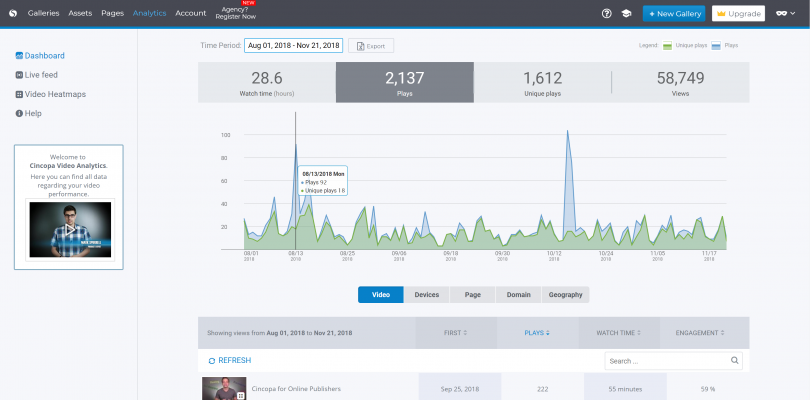In today’s digital age, marketing videos have become a powerful tool for businesses to promote their brand, products, and services. But creating a video is only half the battle. Measuring its success is equally important. In this article, we will explore how to measure the success of a marketing video using analytics.
Before we dive into the analytics, it’s essential to understand the key performance indicators (KPIs) for your video. These KPIs will vary depending on your goals and objectives for the video. For example, if your goal is to increase brand awareness, you may want to focus on metrics such as reach and engagement. On the other hand, if your objective is to drive conversions, you may want to focus on metrics such as click-through rates and conversion rates.
Once you have identified the KPIs for your video, you can start measuring its success using analytics. Here are some of the key metrics that you should track:
Views: The number of views your video receives is a basic metric that indicates how many people have watched your video. It’s important to track this metric to understand the reach of your video.
Engagement: Engagement metrics such as likes, comments, and shares give you an idea of how your audience is interacting with your video. This data can help you understand if your video is resonating with your target audience.
Click-through rate (CTR): CTR is the percentage of people who click on a link in your video to visit your website or landing page. This metric is crucial if your goal is to drive traffic to your website.
Conversion rate: Conversion rate measures the percentage of people who take a desired action after watching your video, such as filling out a form or making a purchase. This metric is important if your objective is to drive conversions.
Completion rate: Completion rate measures the percentage of viewers who watch your video from start to finish. A high completion rate indicates that your video is engaging and holds the attention of your audience.
Demographics: Analytics can also provide demographic information about your viewers, such as age, gender, and location. This data can help you better understand your target audience and tailor your marketing efforts accordingly.
To gather these metrics, you can use various analytics tools, such as Google Analytics, YouTube Analytics, video marketing platform analytics and social media analytics. These tools provide detailed insights into your video’s performance and can help you optimize your video strategy.
In addition to tracking these metrics, it’s essential to set benchmarks and track your video’s performance over time. By doing so, you can identify trends and make data-driven decisions to improve your video strategy.
The 2023 Business Video Marketing Strategy Guide
How to measure the success of a marketing video

The success of a video that was used in a marketing campaign can be determined by measuring its impact on achieving the campaign’s objectives. The specific metrics to track will depend on the objectives of the campaign, but some common indicators of success include:
Increased brand awareness: If the goal of the campaign was to increase brand awareness, then metrics such as views, reach, and engagement can be used to measure success. If the video received a high number of views and engagement, and was shared widely, it indicates that the video was successful in increasing brand awareness.
Improved engagement: If the goal of the campaign was to increase engagement with the brand, then metrics such as likes, comments, and shares can be used to measure success. A high level of engagement with the video indicates that it resonated with the audience and was successful in increasing engagement with the brand.
Increased traffic: If the goal of the campaign was to drive traffic to the website, then metrics such as click-through rates and traffic sources can be used to measure success. If the video drove a high number of clicks and resulted in increased traffic to the website, it indicates that the video was successful in driving traffic.
Increased sales: If the goal of the campaign was to increase sales, then metrics such as conversion rates and revenue generated can be used to measure success. If the video resulted in a high conversion rate and generated significant revenue, it indicates that the video was successful in increasing sales.
Improved customer sentiment: If the goal of the campaign was to improve customer sentiment, then metrics such as sentiment analysis and customer feedback can be used to measure success. If the video received positive feedback and improved customer sentiment towards the brand, it indicates that the video was successful in achieving this objective.
Overall, the success of a video used in a marketing campaign can be determined by evaluating its impact on achieving the campaign’s objectives. By tracking the relevant metrics and analyzing the data, businesses can gain valuable insights into the effectiveness of their video and make data-driven decisions to improve their marketing strategy.
The Top 85 Video Marketing Statistics To Know in 2023
How to measure the success of a YouTube video

To measure the success of a YouTube video, there are several key metrics that you can track. These metrics will help you understand how your video is performing on the platform and whether it is achieving your marketing objectives. Here are some of the most important metrics to consider:
Views: The number of views your video receives is a basic metric that indicates how many people have watched your video. It’s important to track this metric to understand the reach of your video. You can track views in YouTube Analytics, which provides insights into the sources of your views and how they are distributed over time.
Engagement: Engagement metrics such as likes, dislikes, comments, and shares give you an idea of how your audience is interacting with your video. This data can help you understand if your video is resonating with your target audience. You can track engagement metrics in YouTube Analytics, which provides insights into the number and type of engagements your video receives.
Watch time: Watch time measures how long viewers watch your video. It’s an important metric because YouTube’s algorithm considers watch time when ranking videos in search results and recommendations. You can track watch time in YouTube Analytics, which provides insights into how much watch time your video receives and how it compares to other videos on your channel.
Retention rate: Retention rate measures the percentage of viewers who watch your video from start to finish. A high retention rate indicates that your video is engaging and holds the attention of your audience. You can track retention rate in YouTube Analytics, which provides insights into the average view duration and the percentage of viewers who drop off at different points in your video.
Click-through rate (CTR): CTR is the percentage of people who click on a link in your video to visit your website or landing page. This metric is crucial if your goal is to drive traffic to your website. You can track CTR in YouTube Analytics by linking your YouTube channel to your Google Ads account and creating campaigns that promote your video.
Subscriber growth: Subscriber growth measures how many people are subscribing to your channel after watching your video. It’s an important metric because subscribers are more likely to watch and engage with your future videos. You can track subscriber growth in YouTube Analytics, which provides insights into how many subscribers you gain or lose over time.
By tracking these metrics and analyzing the data, you can gain valuable insights into the success of your YouTube video and make data-driven decisions to improve your video strategy.
How to measure the success of a training video

Measuring the success of an online training video is important to determine if the training was effective in achieving the desired outcomes. Here are some metrics to consider when measuring the success of an online training video:
Completion rate: Completion rate measures the percentage of learners who watched the entire video. This metric helps to determine how engaged the learners were and if the video was able to hold their attention. A high completion rate indicates that the video was engaging and informative.
Retention rate: Retention rate measures how much information learners retained after watching the video. This metric is important because it indicates how effective the video was in delivering the learning objectives. A high retention rate indicates that the video was able to communicate the information effectively.
Quiz scores: Quizzes or assessments can be included in the training video to measure learners’ understanding of the material. Quiz scores can be used to determine if the learners comprehended the information and if the video was effective in delivering the learning objectives.
Feedback: Feedback from learners can provide insight into the effectiveness of the training video. Feedback can be collected through surveys or comments. Positive feedback indicates that the video was engaging and informative, while negative feedback can provide insights into areas that need improvement.
Application rate: Application rate measures how much of the knowledge gained from the training video was applied by the learners in their work. This metric is important because it determines if the training was effective in improving job performance. If the learners were able to apply the knowledge gained from the video, it indicates that the training was effective.
Time to competency: Time to competency measures the time it takes for learners to reach a level of competency after completing the training. This metric is important because it determines if the training was effective in improving job performance. If the learners were able to reach a level of competency quickly, it indicates that the training was effective.
By tracking these metrics, you can gain valuable insights into the effectiveness of your online training video and make data-driven decisions to improve your training program.
How To Onboard New Employees Remotely Using Video
How to measure the success of a live stream

Measuring the success of a live stream is important to determine if the event was effective in achieving its goals and engaging the audience. Here are some metrics to consider when measuring the success of a live stream:
Viewership: The number of viewers is a basic metric that indicates how many people watched the live stream. It’s important to track this metric to understand the reach of your live stream. You can track viewership in real-time during the live stream, and afterward, in the streaming platform’s analytics.
Engagement: Engagement metrics such as comments, likes, and shares give you an idea of how your audience is interacting with the live stream. This data can help you understand if your live stream is resonating with your target audience. You can track engagement metrics during the live stream and afterward, in the streaming platform’s analytics.
Retention rate: Retention rate measures the percentage of viewers who stayed throughout the entire live stream. A high retention rate indicates that your live stream was engaging and held the attention of your audience. You can track retention rate in the streaming platform’s analytics, which provides insights into the percentage of viewers who stayed until the end of the stream.
Average watch time: Average watch time measures the average amount of time viewers spent watching the live stream. It’s an important metric because it shows how much time viewers spent engaging with your content. You can track average watch time in the streaming platform’s analytics.
Sales or Conversions: If your live stream is meant to promote a product or service, tracking sales or conversions is essential to measure its success. You can track sales or conversions using tools such as Google Analytics or other conversion tracking tools.
Feedback: Feedback from the audience can provide insight into the effectiveness of the live stream. Feedback can be collected through surveys, comments, or other forms of interaction with the audience. Positive feedback indicates that the live stream was engaging and informative, while negative feedback can provide insights into areas that need improvement.
How to Leverage Live Streaming to Boost Sales
Conclusion
In conclusion, measuring the success of video marketing is crucial for businesses to optimize their video strategy and achieve their marketing goals. By tracking the metrics outlined in this article businesses can gain valuable insights into their video’s performance and make data-driven decisions to improve their video strategy.

